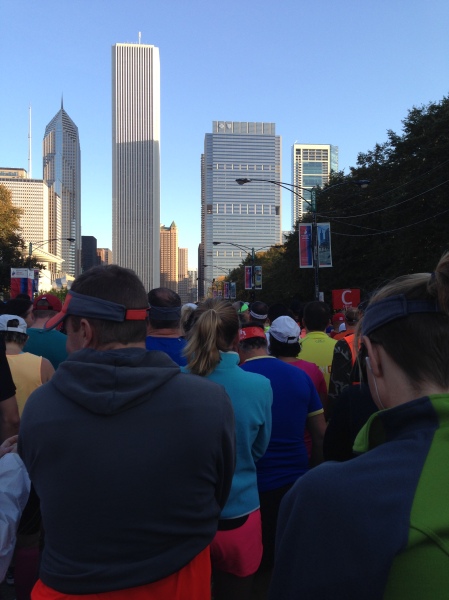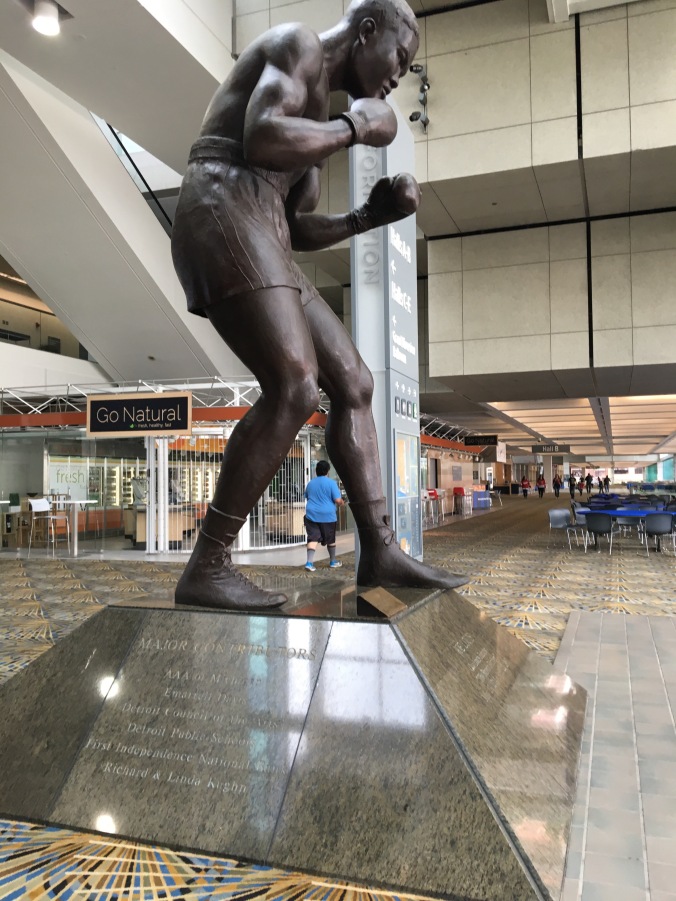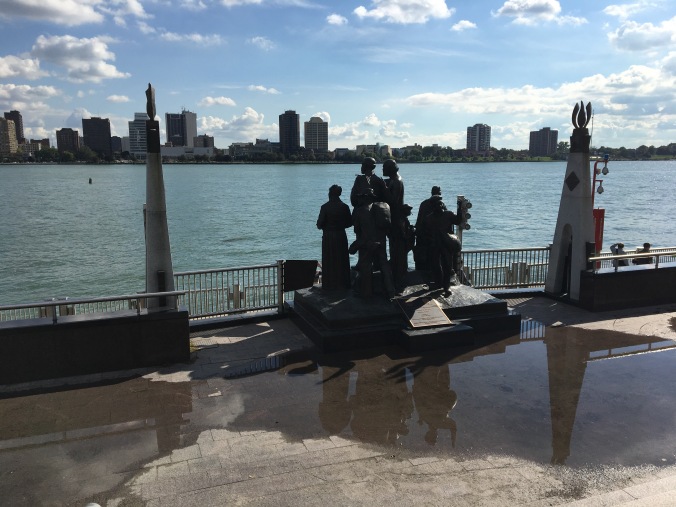A trip to Ann Arbor, Mich., for the Michigan football spring game:
Author: fegbaria
Snapshots: Monday Night Bulls
The Chicago Bulls defeated the visiting Orlando Magic 112-75 on Monday, April 10, at the United Center. A few shots from the 300s:
Snapshots: All around
Snapshots: Road trippin’
From Evanston to Orlando and everything in between.
Snapshots: Chicago Marathon
Chicago Marathon, Part Two: A questionable, inscrutable, exciting decision
Here I am again.
In four days, thousands and thousands of runners will hit the streets of Chicago, with more than a million people watching, for the 2016 Chicago Marathon.
And for the second year in a row, I’ll be among those runners — aching, wondering, laughing, crying (maybe), questioning, pushing.
I wrote about my experience running last year’s marathon, which I finished in just over 5 hours (5 hours, 26 seconds, to be exact). The time didn’t matter — I just wanted to finish the thing, and I did.
I trained, hard, all year. I might have even overdone it, doing 15-, 16-mile runs in April, instead of gradually working my way up, like everybody/everything from Runner’s World to the guy who last ran a marathon in 1973 tell you you’re supposed to do.
The spring flew by, then the summer, then, all of a sudden, the leaves started to drop softly. On the eve of marathon day, I had my spaghetti and wondered how the next morning would go.
As I made my way over to the starting area, I thought to myself: Am I really doing this? What inconceivably misguided emotion or philosophy persuaded me to do this thing?
But it was too late (well, I suppose I could have quit before it started, but that wasn’t really on the table). Off we all went, winding through downtown, up to Addison, back down past the United Center, to US Cellular Field (or Guaranteed Rate Field, when runners pass it by for the 2017 Chicago Marathon).
Five hours later, I crossed the finish line and welcomed the warm embrace of a heat blanket, despite the temperature being somewhere in the mid-70s. At a point of unthinkable physical and mental exhaustion, the mind and body come to appreciate simple things: a nice sit, a cold drink of water, a banana, somebody to talk to about the ridiculous thing that just happened. It has a funny way of stripping inhibition. After walking for a stretch, I found a spot to sit after the race, like so many others, and chatted with a couple of strangers about the experience (that’s not something I’d ordinarily do).
I hobbled about for the next few days, but the excitement didn’t wear off. I couldn’t believe I had actually run a marathon, when just a couple of years prior a five-mile run seemed like an impossibly trying task.
Eventually, though, the running shoes started to collect dust (well, metaphorically). I rested on my laurels, put on a few extra pounds of winter weight, and didn’t drop it come summer, with its parade of street fairs, where you’ll walk and walk and walk but your waist size still creeps upward.
All in all, I’m not nearly as prepared as I was last year. Call it a sophomore slump, but I’m not in the shape I was last October. If I were an English Premier League player, they’d say my fitness isn’t up to snuff.
Was this surprising? No, not really. Sports folks talk about how difficult it is for teams to repeat as champions — especially in hockey — and it’s easy to understand why. When you do something that’s really difficult, you expend a lot of yourself, physically but especially mentally.
And to go through the rigors of it all, only to then try do it again? Well, the mind has a way of telling you to take it easy, whispering soothingly that it’s okay to order a pizza and watch something on TV instead of getting outside and going for a run. What’s one day? One day becomes two days becomes a month of relative inactivity, of net negatives and falling slowly backward.
Now, I am by no means a professional athlete, nor do I mean to compare my personal preparation for a marathon and its rigors in any way to the rigors of, say, an NHL season. But the point about motivation still stands.
Once you’ve done something, like run a marathon, once, what motivates you to want to do it again?
For some truly elite athletes, it’s setting a new blazingly fast PR. For others, it’s qualifying for another race, like the Boston Marathon. For others still, it’s possibly running a marathon with someone else for the first time. Others, maybe, simply want to improve upon their previous time.
I would certainly fall in the last category, although my time ultimately doesn’t mean too much to me (in reality, I don’t know that I will ever have a good enough time to qualify for Boston, but I’m not all that shaken up about it). Sure, maybe something in the range of 4:30 would be great, but after this listless year of training, who knows if that can actually happen. With a renewed sense of purpose, maybe one day hit that mark, or better still, under four hours.
So, if I didn’t run it for time, then why do it again? Why put myself through the pain on race day? Why put myself through the pain of training?
A few weeks ago, I ran my final long run before the marathon, almost 20 miles, down to Oak Street Beach and back to Evanston. On the way back, exhausted and my legs feeling like they had been beaten viciously by an army of microscopic, tiny-hammer-wielding creatures, I sat down on a bus bench in Rogers Park, looking to rest my legs for a few minutes before finishing the last leg of the run.
I looked at the salt crystals on my arms as a 147 bus approached. For a second, I considered getting on that bus, that CTA savior. Never had a bus seemed to arrive so pleasantly on time.
But I didn’t get on, nobly deciding to complete the journey on foot. I limped-ran through the last stretch of Rogers Park, wanting to stop for a bite at Leona’s or Heartland Cafe instead of doing what I was doing.
Unfortunately, the heat was too much, and I eventually stopped around the 19-mile mark and walked the rest of the way. Last year’s 20-mile training capper was difficult, but I didn’t recall it being this difficult … which makes sense. I didn’t prepare the same way, and the results proved it.
Just like in everything, running is about how much you give. If you give a little, you’ll get a little. You’ll wheeze and groan through it, wanting to do anything else but run. If you give a lot, it can give you a lot. Peace of mind, endorphinal bliss, the ability to have dessert without feeling too bad, a better physique, confidence, purpose, something to do.
Whatever your return, it will, more often than not, be proportional to your effort.
Ignoring the fact that my training didn’t turn out to be what I needed it to be this year (anyway, I signed up in the spring in April, well before a training schedule is supposed to begin), I ask myself a simple question.
Why do it again?
The question has a simple and familiar answer: to prove that I can. Just like the first time.
I think I can — but this Sunday will prove it.
Snapshots: Detroit
Snapshots: A little Chicago, a lot of Orlando
A happy 100 for the National Park Service
Memories of times spent gazing at the wonders of nature are timeless. There are places one can visit and be left with a true sense of awe: How could such a thing exist?
And what better day to celebrate this notion than today, which marks the 100th anniversary of the formation of the National Park Service. Without it, who knows what would have happened to so many of the sites we now take for granted as protected spaces: Yellowstone, Yosemite, Arches, Acadia, Badlands, Everglades, and so many others.
On Aug. 25, 1016, then-President Woodrow Wilson signed the bill that would create the NPS, with Stephen Mather as its first director. While this certainly didn’t mark the exact beginning of a nation’s respect for its most treasured places, it gave definition to the idea. With a stroke of a pen, it formalized this bond with the nation’s natural wonders.
Last summer, I had the chance to visit Yellowstone for the first time, exploring the park with my dad and brother. Although I only spent a full day within the park’s vast expanse, the place has left a mental and emotional impression completely disproportionate to my time spent there.
In other words, it has left a mark, like ancient waters slowly but surely carving canyons in the land, snaking slowly through the rock.
For anyone who cares even a little bit about this country’s national parks and their rich history, Ken Burns’ documentary series on the subject — “The National Parks: America’s Best Idea” — probably isn’t unfamiliar territory. I plan on rewatching it in the near future to remind myself of all that it took to preserve these places, and, most notably, how much it took to convince people that they were worth preserving.
One such place was Yellowstone National Park, designated as such well before the inception of the NPS. In 1872, Yellowstone became the country’s (and world’s) first national park.
Since then, many others have received national park recognition — but as we all know, there’s something special about being the first.
Spanning multiple states, Yellowstone is an impossibly vast and diverse place. There are rushing waters, quiet lakes, ambling bison, malodorous sulfur caldrons and the triumphant Old Faithful geyser.
It’s quite easy to become attached to the world of things, tethered to the comforts of modern life: of Wi-Fi, instant access to anything, high-speed communication, social media of all kinds. In the extreme, those things have a dizzying, constraining effect.
But in nature, as people like John Muir, Henry David Thoreau and a great many other naturalists have found, one can escape all of that. In the face of such timeless enormity, untainted and pure, how can you care about the sound of your ringtone when your ears are filled with the orchestra of the outdoors?
I hope I’ll make my way back to Yellowstone someday, and to many other parks on my to-see list. If I never have the chance to go again, I will always remember my day there in June 2015.
And through the work of the people at the National Park Service, spanning a wide variety of job functions, many others will get the chance to carve their day of memories out of the sedimentary rock of Time.
Some shots from my day in Yellowstone, June 2015:














































































































